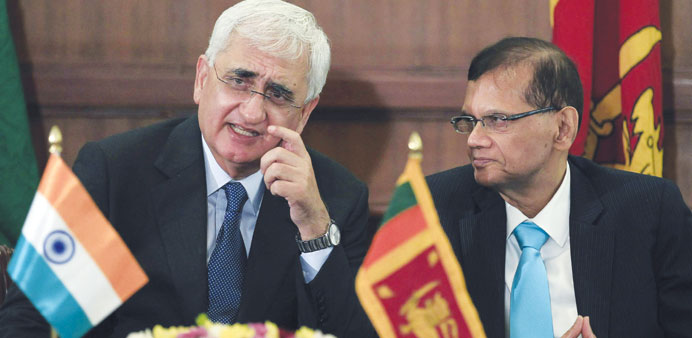|
Sri Lanka and India yesterday announced a finalised $512mn joint venture coal-powered electricity plant in the island’s former warzone, after years of delay. |
The venture between the two South Asian neighbours will see the construction of two power generators of 250 megawatts each in Sri Lanka’s north-eastern district of
Trincomalee.
Sri Lanka’s energy ministry said construction would begin within a year and the plant will be connected to the national grid by 2018, providing cheaper electricity.
Sri Lanka currently depends on expensive diesel powered plants to meet demand that cannot be fulfilled by
hydroelectricity.
The joint venture had been dragging since 2005 due to “various issues”, the ministry said, giving no further details.
Official sources said there had been disagreement over financial issues, including tariffs. Details of the new agreement were not disclosed.
Visiting Indian Foreign minister Salman Khurshid witnessed the signing of the agreements at President Mahinda Rajapakse’s office in Colombo.
The power plant will be located in a former stronghold of the separatist Liberation Tigers of Tamil Eelam (LTTE), who were defeated in May 2009 after
nearly four decades of fighting.
The Indo-Sri Lanka joint venture will be Sri Lanka’s second coal-powered plant. In 2011, the government commissioned the first plant, built with Chinese loans on the northwestern coast of the island.
Sri Lanka’s electricity tariffs are among the highest in the world. Electricity demand in the country is rising sharply, with the island’s economy recording growth rates of over 8% immediately after the end of hostilities.
Khurshid who arrived in Sri Lanka yesterday was to hold talks that would cover attacks on and arrests of Indian fishermen.
He will meet President Mahinda Rajapakse to discuss the devolution of power to the northern province, a former war zone where Tamils are in an
overwhelming majority.
Khurshid is expected to get a tough message from Sri Lanka’s fishing industry over thousands of Indian fishermen poaching in Sri Lankan waters.



